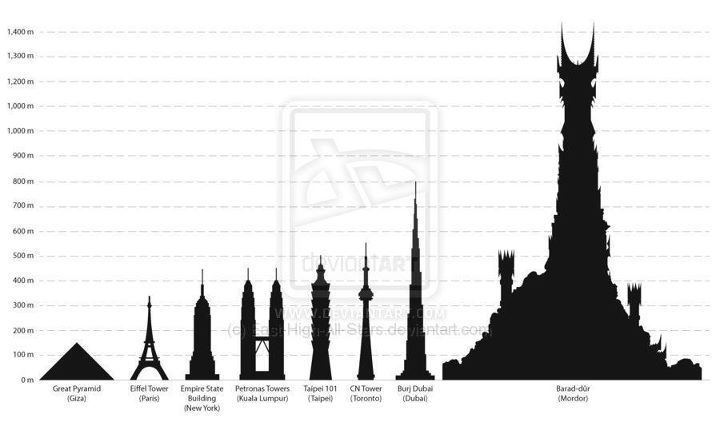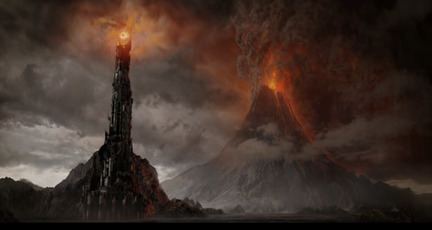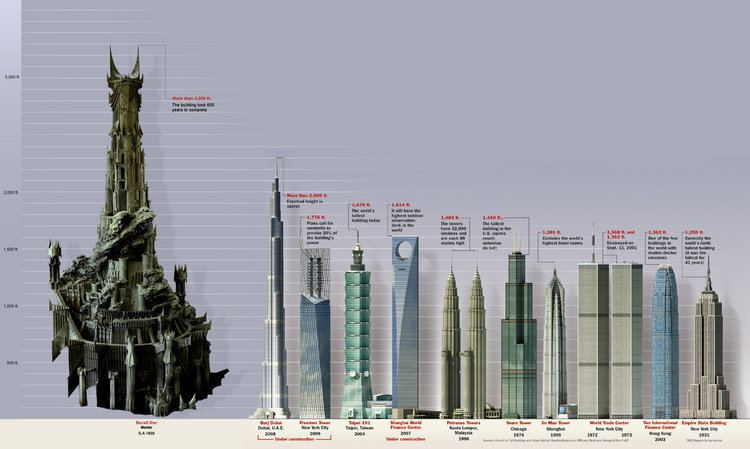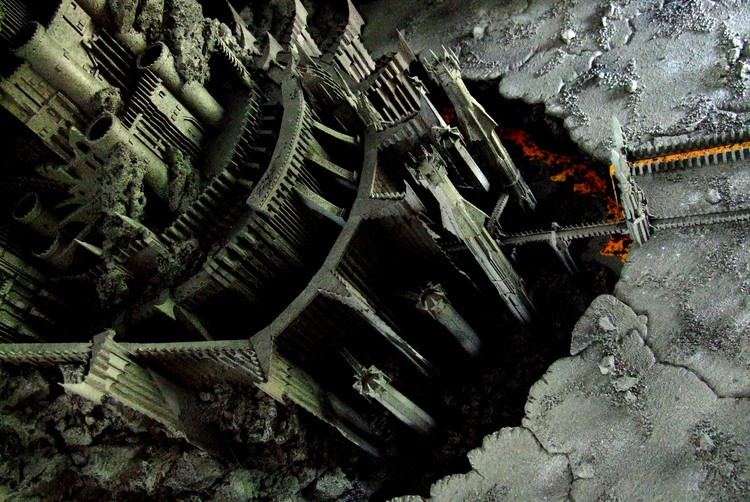Founder The Necromancer | ||
 | ||
Lifespan Second Age c. 1600 to Third Age 3019 Similar Isengard, Dol Guldur, Journeys of Frodo | ||
Barad-dûr, the “Dark Tower,” is a fictional place in J. R. R. Tolkien's Middle-earth writings and is described in The Lord of the Rings, The Silmarillion, and other works. It is an enormous fortress of the Dark Lord Sauron, whence he rules the volcanic and barren land of Mordor. Located in northwest Mordor, near Mount Doom, the Eye of Sauron keeps watch over Middle-earth from its highest tower. The name is pronounced "Ba'rad doorr" with emphasis placed on the "rr." The Lieutenant of Barad-dûr is the Mouth of Sauron, who acts as an ambassador and herald for Mordor and Sauron.
Contents
- Lotr barad d r the dark tower
- Etymology
- Geography
- Description
- Depiction in adaptations
- The Second Age
- The Third Age
- Concept and creation
- References

Barad-dûr was completed by Sauron in 1600 of the Second Age. It was destroyed following the victory of the Last Alliance of Elves and Men at the end of the age. Rebuilding began in the Third Age, 67 years before the War of the Ring. As the Dark Tower is held together by Sauron's magic, it collapses upon the destruction of the One Ring.

Lotr barad d r the dark tower
Etymology

In the Elvish language Sindarin, Barad-dûr translates Barad = Tower and Dûr = Dark, this is rendered into English as the “Dark Tower.” Barad-dûr was called "Lugbúrz" in the Black Speech of Mordor, which also translates as "Dark Tower"; it is composed of Lug = Tower and Búrz = Dark. The Black Speech (created by Sauron) was one of the languages used in Barad-dûr. The soldiers there used a debased form of the tongue. In The Lord of the Rings "Barad-dûr," "Lugbúrz," and the "Dark Tower" are occasionally utilized as metonyms for Sauron.
Geography
The Dark Tower was at the end of a south-western offshoot of the Ash Mountains, the mountain range that ran eastwards from the Black Gate of Mordor. Barad-dûr was above the arid valley of Gorgoroth, and lay south-east of Udûn and the Black Gate.
From the fortress’s east entrance a road went north then west to the Isenmouthe. Frodo and Sam travelled part of this route on their way south to Mount Doom. A second route "Sauron’s Road" went from the west gate of Barad-dûr westwards across Gorgoroth to Mount Doom’s "Chambers of Fire." This road ran from Barad-dûr between two smoking chasms and then reached the causeway that led to the mountain. B. Strachey's Journeys of Frodo estimates Mount Doom was probably no more than 10 miles west of Barad-dûr because Sauron's Road from Barad-dûr to the causeway was only a league (about 3 miles) long. However, the Thain's Book website estimates the total distance was about 30 miles. From Mount Doom the road went southwest to Minas Morgul.
Description
In The Two Towers Barad-dûr is described as:
“...that vast fortress, armoury, prison, furnace of great power...”The same paragraph goes on to say the Dark Tower had ‘immeasurable strength.’ The fortress was constructed with many towers and was hidden in clouds about it:
"...rising black, blacker and darker than the vast shades amid which it stood, the cruel pinnacles and iron crown of the topmost tower of Barad-dûr."It could not be clearly seen because Sauron created shadows about himself that crept out from the tower. In Frodo’s vision on Amon Hen, he perceived the immense tower as:
"...wall upon wall, battlement upon battlement, black, immeasurably strong, mountain of iron, gate of steel, tower of adamant... Barad-dûr, Fortress of Sauron."“Tower of adamant” is probably intended to suggest the tower was composed of extremely hard material. There was also an incredibly high look-out post, called the "Window of the Eye" at the top of the Dark Tower. This window was visible from Mount Doom where Frodo and Sam had a terrible glimpse of the Eye of Sauron.
Barad-dûr’s west gate is described as “huge” and the west bridge as “a vast bridge of iron.” This spanned a deep abyss and carried Sauron’s Road from the gate to Mount Doom.
In The Return of the King, Sam Gamgee witnessed the destruction of Barad-dûr:
“... towers and battlements, tall as hills, founded upon a mighty mountain-throne above immeasurable pits; great courts and dungeons, eyeless prisons sheer as cliffs, and gaping gates of steel and adamant...”Depiction in adaptations
For Peter Jackson's The Lord of the Rings film trilogy (2001–2003), Richard Taylor and his design team built an 18 ft (5 m) high miniature ("big-ature") of Barad-dûr. Jackson's The Lord of the Rings: The Return of the King movie (2003) showed Barad-dûr as clearly visible from the Black Gate of Mordor, which is not the case in Tolkien's book. Some of the maps of Mordor in The Lord of the Rings film trilogy were altered from those in Tolkien's The Return of the King so that the inner mountain ridges of Udûn were not shown and therefore did not obstruct the view.
Like the other strongholds of evil in the novel, i.e. Isengard, Minas Morgul and the Black Gate, Jackson portrayed Barad-dûr in "an exaggerated Gothic fashion" using black metallic structures.
In the Black Gate scene, having Barad-dûr visible from the gate meant that Aragorn's army could see the Eye of Sauron staring at them. This was done because of the deleted "Aragorn versus Sauron" scene. Originally there would be a "blinding light" and Aragorn would see Annatar (Sauron's pleasant appearance that he had used to deceive the Elves in the Second Age), who would then become Sauron and attack. However, the filmmakers decided that this deviated too far from the books, so instead the blinding light scenes were used to depict a "staring contest" between Aragorn and the Eye of Sauron. Again another deleted scene in the extended edition of The Return of the King (2003) appeared to reinforce this view as it showed Sauron standing atop his tower and briefly being observed by Aragorn.
Furthermore, in the films, the Eye of Sauron was portrayed as a gigantic eye on top of the topmost tower of Barad-dûr. This took a literal interpretation of the descriptions of the Eye in J.R.R Tolkien's The Lord of the Rings. However, there are other interpretations of what Tolkien meant by the Eye and the portrayal in the films proved different to that of some Tolkien readers. This is partly because Tolkien described Sauron in a letter in 1963 in the following way:
"The form that he took was that of a man of more than human stature, but not gigantic."According to Tolkien's descriptions in The Lord of the Rings, the Eye was within the ″Window of the Eye″ in the topmost tower, not floating above the tower as shown in Jackson's film trilogy. In the films the Eye was located between two horn-like spires that curved upwards from the tower top; these spires were an invention of the films.
The Second Age
Sauron began to stir again and chose Mordor as his land to turn into a fortress in c. 1000. Barad-dûr was built by Sauron from c. 1000 to c. 1600. It was strengthened by the power of the One Ring, which was also forged around 1600. Gandalf described the Ring as being the "...foundation of Barad-dûr..."
In 3262 Sauron was challenged by a mighty host from Númenor. He submitted to their king and was taken captive to Númenor. He returned to Mordor a year after the downfall of Númenor in 3320.
In 3429 Sauron attacked Gondor, which resulted in Elendil and Gil-galad forming the army of the Last Alliance of Elves and Men. The host entered Mordor and besieged Barad-dûr from 3434-3441. During the siege, Elendil's son Anárion was slain by a stone flung from the fortress. In 3441 Sauron himself came forth from the Dark Tower and fought against Elendil and Gil-galad. Though they were killed in combat, Sauron was also cast down. Anárion’s brother Isildur cut the Ring from Sauron's hand and Sauron was overthrown. Sauron’s armies were defeated and Barad-dûr was captured and levelled to the ground. However, the foundations could not be removed while the Ring still existed.
The Third Age
Sauron had been exiled from Mordor which was under the guard of the men of Gondor for a time. He subsequently built the fortress of Dol Guldur in Greenwood the Great. Due to the Great Plague, Gondor was unable to continue to man its forts, and Mordor was left unguarded from 1640.
In 2000 Minas Ithil was besieged by the Nazgûl, and fell in 2002 and was renamed Minas Morgul. Its palantír was seized and was later taken to Barad-dûr sometime after it had been rebuilt.
In 2941 Dol Guldur was attacked by the White Council. Sauron withdrew and the following year returned secretly to Mordor.
In 2951 Sauron began rebuilding Barad-dûr. The fortress was able to be rebuilt more quickly, probably because the foundations were still in place.
Barad-dûr was destroyed for the final time on 25th "March" 3019 when Gollum took the Ring from Frodo and fell into the Cracks of Doom. The Ring was unmade and Sauron was defeated.
Concept and creation
Little information is available on Tolkien’s early concepts and ideas about Barad-dûr and how these developed over time. A painting by Tolkien of Barad-dûr's east side may give some insight in the ways it differs from the descriptions in his work The Lord of the Rings but the work is undated. The picture shows only the left edge of the lower part of a structure that seems to be constructed of immense masonry blocks. The few existing windows are small and either dark or red; one is clearly barred. One high, thin vertical spire is visible in the background. The fortress on this side seems to stand on top of a large monolithic rock, with a relatively flat top and a sheer cliff face. Mount Doom can be seen erupting in the background, with what appears to be a lava stream flowing from there towards Barad-dûr. A narrow stone bridge leads across the chasm to a single door in the tower. The notes accompanying the painting in Pictures by J.R.R. Tolkien describe it as follows:
"The painting shows a door on the eastern side of the fortress with Mount Doom to the westward."In J.R.R Tolkien’s The Fellowship of the Ring, the Dark Tower is described as being composed of iron, being black in colour and having battlements and gates. In the painting the walls are of mainly grey stone and brick, and battlements, gates and towers are not visible.
